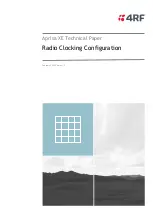
40
SMARTNET/SMARTZONE/P25 TRUNKED FEATURES
SECTION 6 SMARTNET/SMARTZONE/P25 TRUNKED FEATURES
6.1 INTRODUCTION
An overview of the SMARTNET/SmartZone and
P25 trunked operating modes is located in Section 3.7.
The following information describes the features
unique to these modes of operation. Refer to the
“Radio Wide Features” section starting on page 18 for
information on features common to all operating
modes.
6.2 ANALOG AND DIGITAL OPERATION
Either analog or digital operation can be selected
for communication on SMARTNET traffic channels.
Each talk group can be programmed for either type of
operation. Digital operation may be an optional
feature.
6.3 VIEWING UNIT ID
When power is turned on with a SMARTNET/
SmartZone channel selected, the five-digit Unit ID
from 1-65,535 is briefly displayed as IDxxxxx. When
a P25 channel selected, the eight-digit unit ID from
1-16,777,216 is displayed (see Section 5.16.1).
6.4 STANDARD GROUP CALLS
6.4.1 INTRODUCTION
Standard calls are between you and another
mobile, group of mobiles, or a control station (a radio
in a fixed location). Most calls are probably this type.
Proceed as follows to place and receive group calls:
6.4.2 PLACING A STANDARD GROUP CALL
1. Turn power on and set the volume as described in
Section 3.1. Select the channel programmed for the
talk group you want to call (see Section 3.4.2).
2. If the talk group is programmed for encryption and
is not strapped to Clear or Coded, select the desired
mode by pressing the
C/S (
Clear/Secure) option
switch. The status of that switch is ignored if the talk
group is strapped to Clear or Coded. Refer to
Section 11.3 for more information.
3. Press the PTT switch and begin talking. An optional
talk permit tone may sound to indicate when talking
can begin. Other indications that may occur are as
follows:
•
If in the secure mode and your radio is not
programmed with the proper encryption key,
“KEYFAIL” is displayed and the call must be
made in the clear mode or the proper key must be
programmed.
•
If the busy tone sounds and “BUSY” is displayed,
the system is busy. Release the PTT switch and
wait for the call back tone to sound. Then press the
PTT switch within 3 seconds.
•
If a continuous tone sounds and “NO SYS” is
displayed, you may be out-of-range. Drive closer
or away from shielding objects and try again.
•
If your unit ID is invalid, the call is being made to
an invalid group ID, or group calls are not enabled,
“DISABLED ID” is displayed and an alert tone
sounds.
•
If an attempt is made to change an analog channel
from the clear to the secure mode and there is no
available secure channel, “NO SEC” is flashed, an
error tone sounds, and the call is terminated.
•
If an attempt is made to change an analog channel
from the secure to clear mode, “SEC ONLY” is
displayed, an error tone sounds, and the call is
terminated. (Calls on digital channels can be
changed if they are not strapped to clear or secure).
•
If the Secure mode is selected by the
C/S (
Clear/
Secure) option switch and an attempt is made to
transmit on a channel strapped as Clear, “Clear
Only” is displayed and the transmitter is disabled.
Likewise, if the Clear mode is selected and the
channel is strapped as secure, “Secure Only” is
displayed and the transmitter is disabled.
6.4.3 RECEIVING A STANDARD GROUP CALL
Calls are received on only the talk group and/or
announcement group programmed for the selected
















































